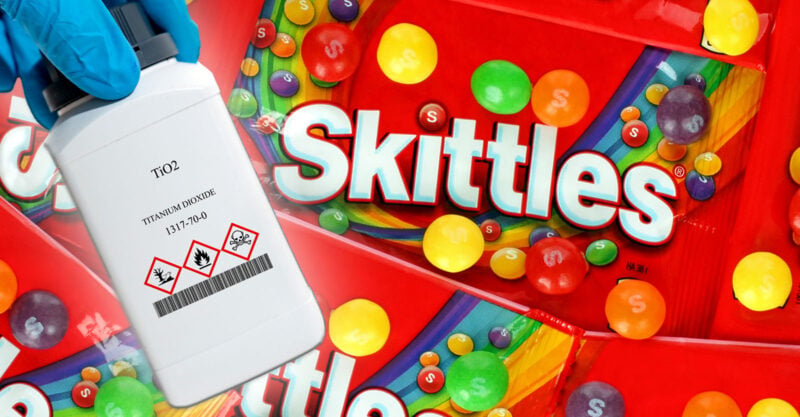‘Skittles Bill’: California to Ban 5 Food Additives Linked to Cancer, Hormone Disruption
California’s Assembly Bill 418 targets red dye No. 3, titanium dioxide, brominated vegetable oil, potassium bromate and propylparaben. The additives, found in popular candies and processed foods, are linked to health problems including cancer and hormone disruption.

Miss a day, miss a lot. Subscribe to The Defender's Top News of the Day. It's free.
By Shannon Kelleher
After years of U.S. debate over widely used food additives, California is poised to become the first state in the nation to ban five ingredients found in popular candies and other processed foods.
Assembly Bill 418, which was passed by the California State Assembly in May, targets red dye No. 3, titanium dioxide, brominated vegetable oil, potassium bromate and propylparaben — additives linked to health problems including cancer and hormone disruption.
If successful, the bill would ban these ingredients, which are used in Skittles, Hot Tamales and Sour Patch Kids, by 2025. The California Senate Committee on Health was expected to vote Wednesday on whether to move the bill forward.
Critics say the additives have not been meaningfully reviewed by the U.S. Food and Drug Administration (FDA) in decades despite scientific updates on their health risks, and that an FDA loophole has allowed thousands of chemicals to enter the U.S. food system without proper safety reviews.
They hope the California bill will help kick off broader nationwide efforts to reevaluate harmful food additives and ban those that jeopardize Americans’ health.
New York lawmakers proposed a similar bill in March, and earlier this month, Illinois Congresswoman Jan Schakowsky reintroduced the Food Chemical Reassessment Act, which targets food additive reforms at the federal level.
The bill seeks to create an Office of Food Safety Assessment within the FDA that would reevaluate chemicals that slipped into Americans’ favorite snacks without proper or recent review by the agency.
“I think [the California bill] demonstrates that FDA is not doing its job,” said Brian Ronholm, Director of Food Policy at Consumer Reports, which is co-sponsoring the bill with the Environmental Working Group.
“They don’t have the ability to go back and re-review some of these additives that have been approved in the past, so therefore they haven’t looked at these in many years.”
“All the substances in California Bill 418 have been evaluated by the FDA,” said an FDA spokesperson in an email.
“When we identify new data and information that indicates the use of an ingredient is unsafe, we take steps to protect public health, which can include revoking authorizations or approvals for certain uses, working with industry on voluntary market phase-out agreements and recalls, issuing alerts and informing consumers.”
Food industry opposition
While the bill made it through the California State Assembly, it still has a long journey ahead before it would be signed into law.
The bill is currently supported by several dozen health and consumer safety organizations, according to a recent analysis, but is opposed by 16 major food industrygroups, including the American Bakers Association, the California Grocers Association and the International Association of Color Manufacturers.
This opposition could make the bill’s journey through the Senate a rocky ride, said Susan Little, Senior Advocate for California Government Affairs at Environmental Working Group.
“All sectors of industry — food manufacturers, grocers, large businesses — are actively working to kill the bill,” said Little. “Now that the bill is halfway through the legislature, industry is trying to stop the bill before it reaches the governor.”
In a June 8 letter addressed to Susan Eggman, chair of the Senate Committee on Health, industry groups said the measure “usurps the comprehensive food safety and approval system for these five additives and predetermines ongoing evaluations.”
“The California assembly is well-intentioned, but this is not the right way to do it,” said Christopher Gindlesperger, Senior Vice President of Public Affairs & Communications at the National Confectioners Association, which signed the opposition letter.
“We should be relying on the science-based rigor of the federal regulatory process — and avoiding a state-by-state patchwork approach related to food additives and ingredients.”
Unnecessary additives
Despite the industry pushback, the bill would not prevent Skittles and other candies from being sold in California so long as manufacturers exclude prohibited chemicals, said Ronholm.
The five food additives in question would hardly be missed if they were omitted from the manufacturing process altogether, according to Maricel Maffini, an independent consultant and food additives researcher.
“I don’t see any of the chemicals that are in the California bill as essential for food uses,” she said.
Red dye No. 3 and titanium dioxide are both added to give food color. Potassium bromate, a popular bakery staple, strengthens the dough, while brominated vegetable oil prevents ingredients of certain drinks from separating and propylparaben acts as a preservative.
Along with other additives, including nitrates and phthalates, these ingredients can disrupt the functioning of the thyroid gland, which releases hormones that are important for metabolism and crucial for the brains of developing fetuses in pregnant women, said Maffini.
Some can also accumulate in the body over time, including nano-scale titanium dioxide particles, which are able to pass through the gut and enter the bloodstream.
“The problem with chemicals that accumulate is that any information you have about their toxicity, any studies that were done before there was evidence of accumulation, are not reliable anymore,” said Maffini. “It’s hard to do an experiment where you consider that.”
When industry takes action
Companies can easily choose to leave harmful additives out of their manufacturing processes, said Ronholm, noting that cost-effective substitutes are often readily available. Skittles and Sour Patch Kids candies free of banned additives can be purchased in the European Union, he said.
“Essentially what these candy companies are doing is they’re subjecting Americans to inferior products,” said Ronholm.
Even in the absence of legal requirements, some companies have moved away from the additives. Dunkin’ Donuts announced in 2015 that it would no longer use titanium dioxide in its pastries, for example, and in 2017, Panera Bread declared that its menu was free from all artificial flavors, preservatives, sweeteners and colors from artificial sources.
General Mills announced it would replace the synthetic colors in Trix cereal with dye from radishes, purple carrots and turmeric in 2015. But after customers complained that the cereal had lost its brilliant glow, the company brought back “Classic Trix” to grocery store shelves two years later.
“Hey, Trix fans! We heard you!” General Millssaid in a 2017 video announcing the return of “Classic Trix.” The video displayed a montage of customer Tweets complaining the company had ruined their vibrant childhood favorite with “brown bland pieces” that “blend in well with carpet.”
A longstanding loophole
Ultimately, the FDA, not the food industry, is charged with protecting Americans from harmful chemicals in the products they consume. But the regulatory agency’s actions over the past few decades have been a far cry from the protections consumers need, said Ronholm.
“You rarely see any type of really meaningful strategic planning or strategic thinking on food issues at the agency,” he said.
“There’s very little accountability. That has allowed a lot of these issues to build up over time and reach the critical point we’re in now, where there are a lot of things out there like these five chemicals that really need to be reevaluated.”
In addition to a lack of leadership focusing on food issues in the agency, the FDA is “chronically underfunded…especially on the food side,” said Ronholm.
Rather than undergoing assessments by the FDA before appearing on the market, about 99% of chemicals introduced since the year 2000 were certified by the industry itself through the “generally recognized as safe” (GRAS) program, a loophole that watchdog groups say allows the food industry to skip safety checks for new ingredients.
Food manufacturers who introduce new food chemicals through the GRAS program are required to provide an explanation detailing how they considered the cumulative health effects of a new additive. In a 2020 study, Maffini and colleagues analyzed all 877 notices submitted to the FDA under the GRAS program since it began in 1997.
When the researchers looked at whether the companies that submitted notices had performed the required assessments — and whether the FDA had asked them to — they found nothing.
“We didn’t find any of them that have considered cumulative effects,” said Maffini. “We didn’t find any requests from FDA to the company to do it either.”
“For far too long, FDA has allowed the food industry to regulate itself, while ignoring consumers’ concerns,” said Jaydee Hanson, Policy Director at the Center for Food Safety, in response to the review.
“Instead of requiring food manufacturers to notify FDA whenever new chemical substances are added to our food, FDA allows these manufacturers to self-certify in secret that their additives are safe.”
“All the substances mentioned in the California bill have been reviewed under the FDA’s pre-market approval process,” said an FDA spokesperson. “Only certain, specific uses of potassium bromate and propylparaben are considered GRAS.”
Federal action on the horizon?
While studies have long shown that some chemicals used in processed foods are unsafe, the FDA has continued to allow manufacturers to use them.
The FDA has known since the early 1980s that red dye No. 3, for example, causes thyroid cancer in animal studies, leading it to ban the use of the dye in cosmetics in 1990.
However, thirty years later the chemical is still permitted in US food products. Red dye No. 3 is found in hundreds of candies and other food products marketed to kids despite research pointing to links between the food dye (among others) and hyperactivity in children.
Other additives the California bill proposes banning simply haven’t been reviewed for safety by the FDA since the 1960s or 1970s.
“Recently, [FDA] has begun to pay more attention to food policy issues in general,” said Ronholm. “That is encouraging. But at the same time, it’s far too early to tell whether that will eventually translate into meaningful action.”
The FDA is currently reviewing petitions that call for the agency to revoke regulations that allow red dye No. 3 to be used in food and ingested drugs as well as the regulation that allows titanium dioxide to be used in food.
The agency is also proposing a rule to revoke authorization for the use of brominated vegetable oil as a food ingredient based on new scientific information the agency reviewed while reassessing the ingredient.
Originally published by The New Lede.
Shannon Kelleher is a reporter for The New Lede.


No comments:
Post a Comment